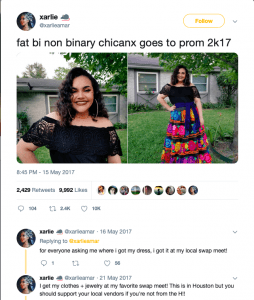https://www.instagram.com/p/Bw8MFSpg0oD/?igshid=e4pisahq8qfn
My instagram essay reflects on the centuries of violations afflicted upon the islands of Puerto Rico. Within my essay the topics of post-colonial Puerto Rican identity are explored through selected quotes from academic papers on the colonial status of Puerto Rico and its decolonization. Authors of the quotes I have included are Aurora Levins Morales, Gloria Anzaldúa, Eileen Findlay, Carmen Lugo-Lugo, Lynn Fujiwara, Anouk Essyad, and Pedro Malavet.
Creating my quote essay I was immediately drawn to Aurora Levin Morales’ poetic writing in Remedios: Stories of Earth and Iron from the History of Puertoriqueñas. The first quote slide from Remedios is meant to reflect the on current state of Puerto Rico by acknowledging its experience of colonial abuses. The idea of decolonization is promoted through the recognition of finding “. . . the voices of the conquered of my island” (Morales, 55). My second quote is also from Remedios and focuses on the rape of the Puerto Rican islands and their people. This quote on rape was the first one I picked as part of my project, I personally find it very disturbing. My third quote from Malavet America’s Colony is meant to represent the post colonial reality of the modern lived experience of Puerto Ricans stuck between the worlds of the oppressed fighting and living under the oppressor. My fourth slide is from Gloria Anzaldúa’s Borderlands, and though her main focus is the social location of Chicanx people in the US Anzaldúa’s quote reminisces of indigenous pride. In my narrative I imagine a connection between a Boriken women choosing to embrace her indigenous roots as a form of resistance in a settler white supremacist society. My fifth and sixth slide discuss the commodification of Puerto Rico and its queerness by quoting Lugo-Lugo’s Getting to the Colonial Status through Sexuality: Lessons on Puerto Rico’s Political Predicament from Women Writers (236). My sixth slide reinforces the idea though we can use feminism as an inherently queer space, but we cannot not forget to assert the rights and importance of why we need feminism as a queer place. My seventh and eighth slide focus again on the metaphor and literal rape of Boriken women and the disavowal that has accompanied these historical violations. It is no coincidence that the spanish word for rape is simply violación. The ninth slide is one of the most powerful of in my opinion. The bones that are referenced as being in an unknown location are that of African and Boriken people forced into slavery where they most likely worked until death. At the same time the infrastructure of the US and its territories were builts brick by brick on the back of those forced into slavery. My tenth slide display hope and a call to action on how to resist “genocidal history settler colonialism” (505).
I do not personally share any personal connections to my project and its narratives. If anything my identification would be most similar to the social location of the privileged settler. My project is therefore a reflection and extension of what I have learned and continue to educate myself with through this class.
Anzaldúa, Gloria. Borderlands La Frontera. Second, Aunt Lute Books, 1987. p. 104.
Essyad, Anouk. “Feminist Studies : Decolonial and Postcolonial Approaches : A Dialogue.” Nouvelles Questions Féministes, vol. 37, no. 1, 2018, p. 505. doi:10.3917/nqf.371.0170.
Findlay, Eileen. Imposing Decency: The Politics of Sexuality and Race in Puerto Rico, 1870-1920. Duke University Press, 1999. p. 56
Fujiwara, Lynn, and Shireen Roshanravan, editors. Asian American Feminisms and Women of Color Politics. University of Washington Press, 2018. p. 90
Lugo-Lugo, Carmen R. Getting to the Colonial Status through Sexuality: Lessons on Puerto Rico’s Political Predicament from Women Writers. 2018. p. 235, 236,
Malavet, Pedro A. America’s Colony: The Political and Cultural Conflict between the United States and Puerto Rico. New York University Press, 2004. p. 6
Morales, Aurora Levins. Remedios: Stories of Earth and Iron from the History of Puertorriqueñas. South End Press, 1998. p. 55, 65, 93,
